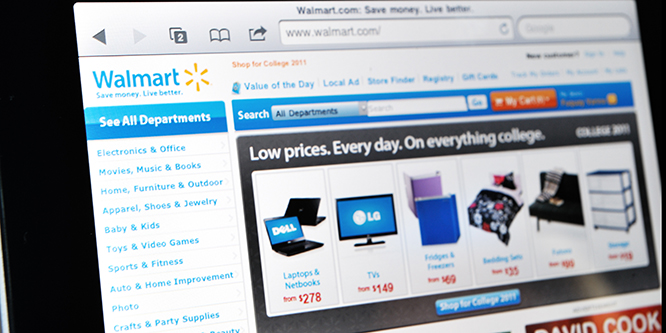
Photo: Getty Images / EricVega
March 9, 2023
Walmart’s plan to improve margins is built on ad and B2B service sales
Walmart has a greater combination of business-building tools and access to customers than any other retailer in the U.S. The retailer plans to use those tools and that access to diversify its revenue streams and drive greater profitability going forward.
John David Rainey, chief financial officer for Walmart, speaking this week at the Raymond James Institutional Investors Conference, said the company expects a higher percentage of its sales and profits to shift to ad sales, third-party marketplace sellers and B2B services.
Walmart’s advertising success is driven by traffic to its stores, app and walmart.com.
Mr. Rainey said, “more advertisers want to spend money” with Walmart as it attracts more shoppers. He said that advertising margins typically fall in the 70 to 80 percent range and can change the composition of the company’s profit and loss statements. Insider Intelligence expects Walmart’s ad revenues to grow 42 percent in 2023.
He pointed to the fees Walmart makes from third-party sellers on its marketplace as another means to higher revenues and profits. Walmart has increased the fees it receives from third-party sellers by giving them access to its fulfillment technology and services.
Mr. Rainey also identified opportunities to partner with business customers looking to take advantage of Walmart’s scale. He pointed to the chain’s broad network of stores across the U.S., putting the retailer within 10 miles of most American households. This market saturation and the systems Walmart has developed to run its own business have put it in a position to serve as a solution provider for others.
Walmart is not alone in trying to monetize advertising and services to boost its top and bottom line performance.
Amazon.com generates more than half of its e-commerce revenues from third-party marketplace sellers. It is also the largest retail media provider and trails only Google and Facebook when it comes to digital ad sales, according to Insider Intelligence research cited by CNBC.
Discussion Questions
DISCUSSION QUESTIONS: How do you expect Walmart’s marketplace, ad sales and B2B services to affect its business over the next five years? How will Walmart’s progress on these fronts compare to rivals, including Amazon, Kroger, Target, et al.?
Poll
BrainTrust
Carol Spieckerman
President, Spieckerman Retail
Jeff Sward
Founding Partner, Merchandising Metrics
Lisa Goller
B2B Content Strategist
Recent Discussions








I expect Walmart to have a lot of success with its advertising and media offering. I also think there is potential in B2B sales, although it faces stiff competition from Amazon which is also trying to grow this part of its business. I am less confident about the marketplace as, quite honestly, Amazon’s website has become a hot mess — cluttered with random products and illogical prices from third-party sellers. There needs to be a lot more discipline in curating the marketplace and products.
Spot on about the “hot mess” of marketplaces. And just to note that Amazon lost profits in its North American business last year to the tune of $2.8 billion.
Marketplace will see linear growth, ad sales will see exponential growth, B2B is unclear and doesn’t quite have the momentum yet. In ad sales, the exciting part will be in-store offline ads. Expect to see the rest of the retail industry also tap into the growth initiatives that Walmart spends on as well. Roundel, Kroger Precision Marketing and many others will drive new revenue as part of their retail media, but Walmart will continue to lead in this space by tapping into new ways of advertising through physical properties. Amazon currently has an enormous lead that will grow as well, but this will be at a linear pace as Amazon traffic remains stagnant. There will be innovation on the Amazon side to grow its ad market, we just haven’t seen it yet.
Walmart exemplifies the business model diversification that will drive retail forward. Walmart’s forays into solutions and services serve as a powerful hedge against product-based headwinds and the growth potential for endemic and non-endemic ad sales is near limitless.
Walmart is poised to win big by selling to businesses over the next five years. As the most pervasive omnichannel retailer, Walmart has evolved into an irresistible magnet for consumers and companies.
Walmart’s strategic partnerships (Shopify, FedEx, Salesforce) increase Walmart’s retail power. Amazon is the retail media leader, and a logistics and proprietary tech trailblazer. Now more retailers seek growth from expanding their own ad, tech and logistics offerings to B2B buyers.
Ad margins: 70 to 80 percent. Walmart’s typical operating margin: barely 4 percent. Any questions? Really, ads and services are great revenue generation engines that require little gas and drive better profitability. Walmart will not be alone in this approach, as others are pursuing the same or similar paths. But considering that there’s a Walmart within 10 driving miles (and zero clicking distance) of the entire U.S. population, they’re going to be tough to beat in this endeavor.
It seems to me that Walmart is building a much more robust retail ecosystem than Amazon can have any time soon. The ads and marketplace are rounding out the massive physical presence that Walmart already enjoys, and that Amazon has no chance of replicating absent a massive brick-and-mortar acquisition. Amazon dominates the web and Walmart dominates the street. Gotta love the competitive dynamic here.
As margins narrow and competition thickens, retailers are looking at other revenue streams including RMN, marketplaces, and B2B. The home run for Walmart is RMN as these advertising opportunities go beyond e-commerce by including in-store displays and mobile devices. The ability to cross-market across channels is a big win for national brands. B2B would allow the world’s largest retailer to create a blueprint of success for other businesses. Sharing its global supply chain and fulfillment network can help other businesses. I agree with Neil about the hot mess of marketplaces; it is an added layer of complexity to the retail model. Walmart had less than 10,000 marketplace vendors pre-pandemic and ended 2021 with over 130,000 third-party sellers. Sounds like a web of confusion for product assortments.
So-called “alternative revenues” are the topic du jour at just about every large retailer these days and the lure behind the rush to establish Retail Media Networks.
Retailers with massive “audiences” like Walmart, Kroger, Home Depot and Albertsons-Safeway are already realizing some of the margin boost that can be possible when they sell a digital product (advertising) with 70 percent or higher net margins alongside their physical products which net around 2 percent to 3 percent.
Other forms of alternative revenue include financial services, technology licensing, marketplaces — even order delivery services for other retailers. No surprise — Walmart is engaged in all of these.
This a very important development because it upends the classic retail financial model. A retailer earning strong alternative revenues may be able to be more price competitive versus others who do not. Regionally powerful retailers (notably grocery chains like Wegmans, Publix, Raley’s, Hy-Vee, Meijer, etc.) are at a disadvantage in this respect because they don’t command national audiences.
This situation has the M&A folks licking their chops.
I would be exceptionally careful about relying on ad sales. Despite their high margins, they come with high risk and can evaporate quickly. At this point they are the fresh new shiny bauble and Walmart doesn’t yet know their risks.
This will do for Walmart exactly what they want it to do — improve their margins. Given Walmart’s historic ability to “focus” (I once had a VP hand me a tiny business card with a lot of price, telling me how much money he saved by having a smaller card!) on initiatives like this, I would expect them to at minimum match their competitors here.
I’ll never bet against Walmart, at least over the long haul. As to how its efforts will compare to other companies, there is going to be significant shakeout in this space, but I think they will be among the survivors.
This is why Walmart continues to be a leading retailer, both in-store and online and beyond. They continue to broaden their financial opportunities. Here’s the way I look at modern retail. If all you do is sell merchandise in a store, you will never reach your full potential. Just look at how Walmart, Target, and Amazon have grown. For the traditional retailer (Walmart and Target), it used to be growth through the number of retail locations. Look where they are now. Look at all the revenue channels. The future of retail is multiple streams of income that are synergistic with the retailer’s core business model.
Walmart’s services will continue to grow because they will continue to experiment. However, they will face the same problems, such as product quality, inventory, and extra fees, that other retailers face with third party suppliers. Having free delivery but then getting hit with seller delivery costs because they are third party sellers is not a good way to encourage customers to purchase third party products. Getting the details right is critical for success.